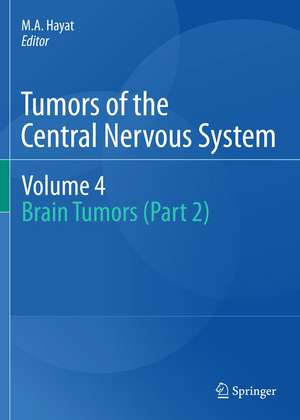Tumors of the Central Nervous System, Volume 4: Brain Tumors (Part 2): Tumors of the Central Nervous System, cartea 4
Editat de M.A. Hayaten Limba Engleză Paperback – 29 noi 2013
| Toate formatele și edițiile | Preț | Express |
|---|---|---|
| Paperback (1) | 1323.87 lei 39-44 zile | |
| SPRINGER NETHERLANDS – 29 noi 2013 | 1323.87 lei 39-44 zile | |
| Hardback (1) | 1338.46 lei 39-44 zile | |
| SPRINGER NETHERLANDS – 5 oct 2011 | 1338.46 lei 39-44 zile |
Preț: 1323.87 lei
Preț vechi: 1393.55 lei
-5% Nou
Puncte Express: 1986
Preț estimativ în valută:
253.33€ • 262.78$ • 211.24£
253.33€ • 262.78$ • 211.24£
Carte tipărită la comandă
Livrare economică 24-29 martie
Preluare comenzi: 021 569.72.76
Specificații
ISBN-13: 9789400738300
ISBN-10: 9400738307
Pagini: 412
Ilustrații: XXVI, 386 p.
Dimensiuni: 193 x 260 x 22 mm
Ediția:2012
Editura: SPRINGER NETHERLANDS
Colecția Springer
Seria Tumors of the Central Nervous System
Locul publicării:Dordrecht, Netherlands
ISBN-10: 9400738307
Pagini: 412
Ilustrații: XXVI, 386 p.
Dimensiuni: 193 x 260 x 22 mm
Ediția:2012
Editura: SPRINGER NETHERLANDS
Colecția Springer
Seria Tumors of the Central Nervous System
Locul publicării:Dordrecht, Netherlands
Public țintă
ResearchCuprins
Introduction.-1. Epidemiology of primary brain tumors.-2. Supratentorial primitive neuroectodermal tumors.-3. Adult neurogenesis in etiology and pathogenesis of alzheimer’s disease .-4. Epileptic and supratentorial brain tumors in children. Part I.tumor to tumor.-5. Breast cancer metastasis to the central nervous system.-6. Melanoma to brain metastasis: photoacoustic microscopy. Part II. Biomarkers and diagnosis.-7. Extraaxial brain tumors: the role of genetic polymorphisms.-8. Central nervous system germ cell tumor.-9. Microvascular gene changes in malignant brain tumors.-10. Role of microrna in glioma.-11.glioblastoma multiforme: cryopreservation of brain tumor-intiation cells(method).-12. Relationship between molecular oncology and radiotherapy in malignant gliomas (an overview).-13. High-grade brain tumors: evaluation of new brain lesions by amino acid pet.-14. Cyclic amp phosphodiesterase-4 in brain tumor biology: immunochemical analysis.-15. Time-resolved laser induced fluorescence spectroscopy (trlifs): a tool for intra-operative diagnosis of brain tumors and maximizing extent of surgical resection. Part III. Imaging.-16. Molecular imaging of brain tumors using single domain antibodies.-17. Quantitative analysis of pyramidal tracts in brain tumor patients using diffusion tensor imagin.-18. Differentiation between gliomatosis cerebri and low-grade glioma: proton magnetic resonance spectroscopy.-19. Peripheral nerve sheath tumors: disgnosis using quantitative fdg-pet.-20. Tumor resection control using intraoperative magnetic resonance imagin.-21. Brain tumors: clinical applications of functional magnetic resonance imaging and diffusion tensor imaging.-22. Trigeminal neuralgia: diagnosis using 3-d magnetic resonance multi-fusion imaging.-23. Epilepsy-associated brain tumors: disgnosis using magnetic resonance imaging.-24. Growth OF malignant gliomas. Part IV. Therapy.-25. Resection of brain lesions: use of preoperative functional magneticresonance imaging and diffusion tensor tractography.-26. Paradigms in tumor bed radiosurgery following resection of brain metastases.-27. Rat model of malignant brain tumors: implantation of doxorubicin using drug eluting beads for delivery.-28. Electromagnetic neuronavigation for cns tumors.-29. Sterotactic radiosurgery for intracranial ependymomas.-30. Is whole brain radiotherapy beneficial for patients with brain metastases?-31. Triggering microglia ontoxicity: a bench utopia of a therapeutic approach?-32. Preoperative motor mapping.-33. Intraoperative monitoring for cranial base tumors.-34. Brain tumors: pre-clinical assesment of targeted, site specific therapy exploiting ultrasound and cancer chemotherapeutic drugs. Part V.Quality of Life.-35. Headaches in patients with brain tumors.-36. Headache associated with intracranial tumors.-37. Patients with brain cancer: health related quality of life.-38. Emerging role of brain metastases in the prognosis of breast cancer patients. Index.
Recenzii
From the reviews:
“The purpose is to address the main achievements in the neuroscience of tumors of the central nervous system. This volume deals with intracranial tumors. Neurosurgeons, neurologists, neuroradiologists, neuropathologists, molecular biologists, radiation therapists, and radiologists are the main audience. … The illustrations, text, and presentation are superb. Excellent in its presentation, content, and up-to-date information, this book deserves a spot in academic libraries serving neurosurgeons and neurologists.” (Celso Agner, Doody’s Review Service, March, 2012)
“The purpose is to address the main achievements in the neuroscience of tumors of the central nervous system. This volume deals with intracranial tumors. Neurosurgeons, neurologists, neuroradiologists, neuropathologists, molecular biologists, radiation therapists, and radiologists are the main audience. … The illustrations, text, and presentation are superb. Excellent in its presentation, content, and up-to-date information, this book deserves a spot in academic libraries serving neurosurgeons and neurologists.” (Celso Agner, Doody’s Review Service, March, 2012)
Textul de pe ultima copertă
This volume mainly contains information on the diagnosis, therapy, and prognosis of brain tumors. Insights on the understanding of molecular pathways involved in tumor biology are explained, which should lead to the development of effective drugs. Information on pathways (e.g., hedgehog) facilitates targeted therapies in cancer. Tumor models are also presented, which utilize expression data, pathway sensitivity, and genetic abnormalities, representing targets in cancer. For example, rat model of malignant brain tumors using implantation of doxorubicin with drug eluting beads for delivery is explained. The future of pathway-driven therapies for tumors is summarized. The importance of personalizing cancer care is emphasized. The need for supportive measures for survivors of brain cancer is pointed out, so is the quality of life monitoring. The need of rehabilitation therapy for patients with primary and metastatic brain tumors is also emphasized. Role of MicroRNA in distinguishing primary tumors from metastatic primary tumors is discussed. Advantages and limitations of chemotherapy (e.g., temozolomide and doxorubicin) are discussed. The complexity of tumor to tumor transfer is explained; examples discussed are: brain metastases from breast cancer and brain metastases fro non-small cell lung carcinoma. Identification and characterization of biomarkers, including those for metastatic brain tumors, are presented. Genomic analysis for identifying clinically relevant subtypes of glioblastoma is included. A large number of imaging modalities are detailed to study progression and invasion of gliomas.
Caracteristici
Personalizing cancer care Role of MicroRNA in distinguishing tumors Genomic analysis of glioblastoma Imaging to study brain cancer Miolecular profiling of brain tumors
























